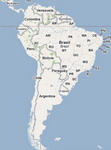Sao Paulo, Brazil: A Traveler's
Guide by BCD Travel
Browse
accommodation in São Paulo
The glamorous industrial
powerhouse
Sao Paulo is the world's third
largest city and the largest in South America. Described as a "concrete
jungle" the city is in constant growth, particularly upwards. The fast-paced
cosmopolitan metropolis may not be the prettiest of cities, but offers
plenty of glamour and tons of South American flair. There's ample to see
and do with top-rate nightlife, restaurants and impressive cultural and
arts scenes.

As a major business hub,
Sao Paulo hosts over 90,000 events every year - largely conventions, conferences,
and trade shows accumulating about R$8 billion (US$ 4.5 billion) in revenue
for the city each year.
The country's official language
is Portuguese but, with its multi-cultural community, many people also
speak English, Spanish, Italian and French. In fact, Brazil is also home
to the largest Japanese population outside of Japan. This diverse cultural
mix has definitely left an impressive mark on the city's dining scene.
As in any other big city,
it is important to take simple precautions to ensure your safety. Keep
your belongings close to you in public places, avoid wearing expensive
looking jewelry or watches and don't carry large sums of money while walking
around the city - there are many pickpockets operating in the area.

Getting to and from the airport:
Sao Paulo's international airport
is Guarulhos Airport (locally known as Cumbica), approximately 25 km northeast
of the city. Travelers can either take a taxi or a bus to the city center.
The cheapest option is to take the airport bus service at R$24 (US$13)
per person, which operates dedicated services to the central Tietê
Interstate Bus Terminal, Congonhas (the domestic airport) and major hotels.
Prepaid taxi fares to the center of Sao Paulo are approx R$66 (US$36).
A regular metered taxi can be a little cheaper; unless you get stuck in
one of the frequent traffic jams.
Getting around Sao Paulo:
The Metro is the easiest way
to get around the central districts of Sao Paulo, although it does not
cover the rest of the city. Metro tickets cost approx.R$2.55 (US$1.40)
for a single ride. The city's buses are plentiful and frequent, but unless
you know the city the system can be hard to navigate. Routes are usually
displayed on the front and sides of the buses and cost approx. R$2.55 (US$1.40).
Note that bus drivers generally won't stop unless you flag them down.
At night, taxis are the safest
mode of transport. Owner-driven taxis known as taxi Comun are generally
well maintained and reliable, as are radio taxis. Note that fares will
increase 25 percent after 8:00 p.m. and on weekends. A tax is also applied
to taxis leaving the city. Good radio-taxi companies usually accept credit
cards, but you must call ahead and request the service.

Places to visit in Sao Paulo:
Jahy Carvalho, BCD Travel's
regional sales manager for Latin America, lives in Sao Paulo and recommends
a trip to the centrally located Ibirapuera Park - a welcome retreat from
the smog-filled chaos of the city. The park has beautiful lakes, fountains,
bicycle paths and a Planetarium. The nearby sites of the Bienal, the Museu
de Arte Moderne and the Pavilhão da Oca host many of the shows that
come to São Paulo.
The Teatro Municipal is located
in the Old City Center and is one of the city's most important cultural
landmarks. Made from sandstone and sculpted red marble, with lavishly decorated
interiors, the theater plays host to numerous operas, concerts and ballets.
The Pinacoteca do Estado
is a beautifully restored museum displaying the works of some of the best
Brazilian artists from the 19th and 20th centuries. During the museum's
1997 renovation, the roof and much of the interior were replaced with glass
latticework and open spaces.
Visit the Vila Madalena neighborhood,
where the main streets are bustling and full of affordable clubs with live
music. If you're into samba (or simply curious about it) then pop into
Salve Simpatia, an energetic Rio-style club, where you can watch the crowd
from the balcony.
Jahy also recommends the
Espirito Santo Bar on Avenida Horácio Lafer, which is a good place
for happy hour with a typical São Paulo atmosphere and authentic
Portuguese influence.

Eating in Sao Paulo:
The city's diversity of peoples
and cultures has engendered restaurants spanning more than 50 different
types of cuisine, making São Paulo a paradise for adventurous, globe-trotting
gastronomes. Try the traditional feijoada, a dish made of black beans,
pork and dry steak. Wash this down with a caipirinha - a cocktail of sugar,
lime and cachaça (distilled sugar liquor).
Shopping in Sao Paulo:
With more than 50 shopping malls
and plazas, numerous artisan fairs and art galleries, plus 42 commercial
blocks, São Paulo is a shopper's paradise. The most popular fashion
spots are Centro Atacadista; Rua Oscar Freire, and Bela Cintra which offer
haute couture on par with Paris' Champs-Elysées or Rodeo Drive in
the USA. Moving away from the high-end market, you can find street sellers
and a Sunday's Art and Crafts Fair in the city center, offering everything
from vintage records to hand beaded flip-flops.
 Browse
accommodation in São Paulo
Browse
accommodation in São Paulo
Top
|








